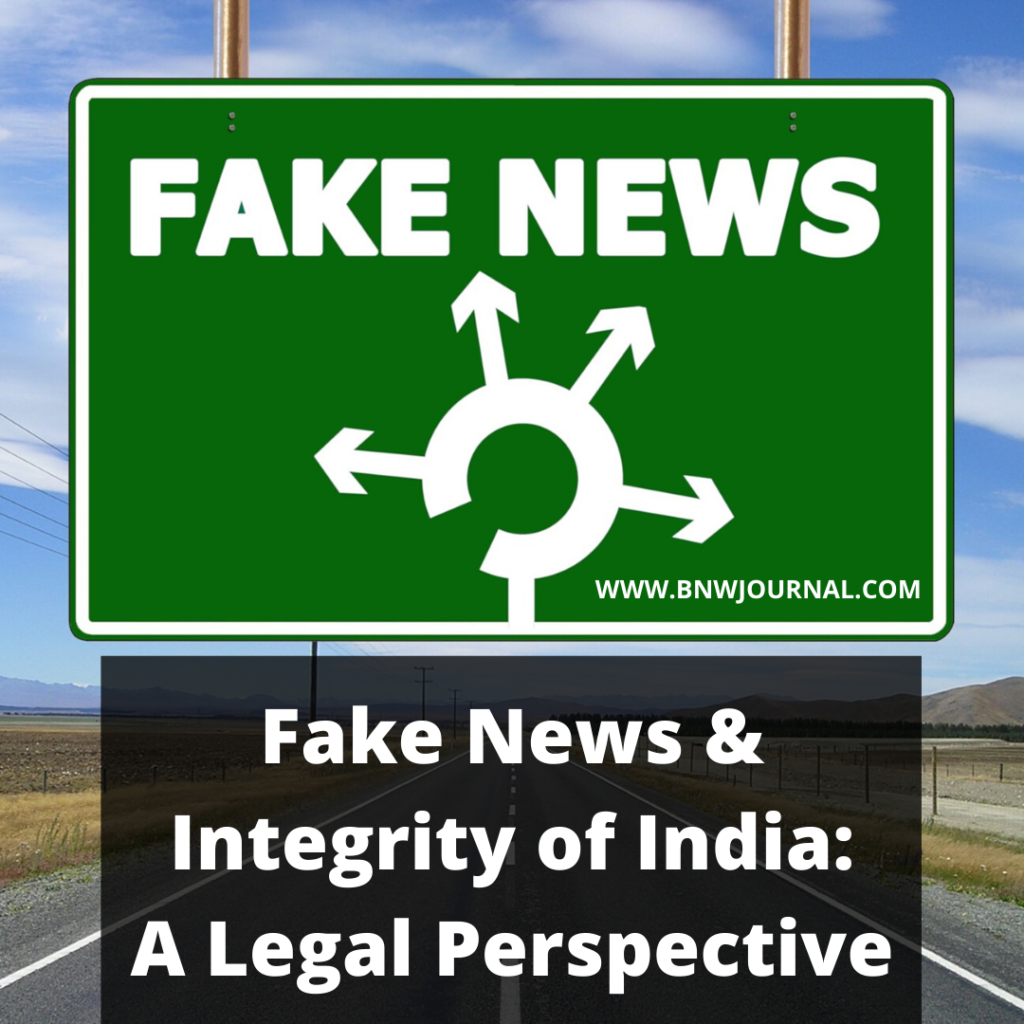![]()
INTRODUCTION
“Alternative facts and fake news are just other names for propaganda”
Johnny Corn

Fake news also known as junk news or spam news is a form of ‘disinformation’. It spreads through news media (print and electronic). It is the spread of rumors in public with the intention of misleading people from concrete facts. Fake newsmakers to deprive people from real facts. It has a huge psychological impact as, when we see a message on our social media portal, we first evaluate whether it matches our opinion. If it satisfies our personal bias, we forward it without even thinking if the particular message has the potential to spread communal disharmony among people or not.
The best example of the above statement is when the Citizenship Amendment Act, 2019 was passed by the government of India. It led to communal disharmony in the country. It is because of misinformation that it had something to do with the targeting of a religious community. But the actual question was whether the secularistic feature of the Indian Constitution was being violated.
Why fake news?
The vast majority of fake news articles are written about public figures or controversial current events and shared via social media with the hope of going “viral.” By linking social media posts to Web sites that contain banner advertisements and/or other promotional content, many publishers of fake news can monetize the resulting Web traffic[1]. These are generally done with yellow journalism quotes. A simple example would be a Whatsapp message that states if you click the provided link it would charge your phone completely, once you do so an advertisement pops up resulting in web traffic.
Fake News types-
Fake news is of various types and the internet is a huge contribution to this for three basic reasons:
(a) Readily accessible to a large number of people, (b) Cost-effective, and (c) Quick. Fake news could be an article with false information that has been negligently published or a picture edited with photoshop or a video tampered with video editing apps. These go viral overnight to seek attention on unnecessary things and sometimes are also just time waste.
INDIAN LEGISLATION
The regulation of the media is extremely important to prevent fake news the existing legislations are not very efficient.
PCI
The Press Council of India (PCI) is an important body formed in 1966 which governs and regulates the media industry. It has certain roles to play as a shield for the autonomy enjoyed by the media sector. But such treaties are indirectly interfering with the independence they enjoy. The PCI is powerless as they have control over only the print media and adjudicate over only certain matters or complaints that come to them, so although they seem to stand for the independence of the media in the country they do not have the power to adjudicate matters that hampers this independence.
Technological upgradation and its effect
As technological up-gradation is on the rise it is important for the laws to favor the scenario. Access to electronic media has increased drastically. News channels on the television, website, and apps of the media houses are preferred over the newspapers. As this is a very cost-effective method to do so. This gives an opportunity to the media houses and the political parties a lot of loopholes to escape from as the Information Technology Act,2000 is not sufficient enough to regulate. As the purpose of the said act is different and the lack of a financial model for this sector makes it all the more alarming. The code of conduct released by the PCI on journalistic norms are not as enforced as they must be.
Landmark cases
In the landmark case of Shreya Singhal v. Union of India[2] struck down 66A of the Information Technology, 2000 which provided for punishment for sending any ‘offensive’ messages or posting ‘offensive’ content. As per Justice J.Chelameshwar with “disproportionately interferes with the right to speak”. Justice Nariman mentioned that “the liberty of thought and expression is not merely an aspirational ideal. It is also “a cardinal value that is of paramount significance under our constitutional scheme”. Here the real question was where the freedom of speech and expression was absolute or not. The judgment made it clear unless in extreme circumstances the state cannot curtail the rights of the citizens. An exception could be defamation as that is a logical reason for the curtailment of the right. As a part of a democratic country, freedom of speech and expression is a foundation stone and stores the essence of all democratic organizations[3].
SOCIAL MEDIA
Now this is a platform that facilitates everything irrespective or good and bad. And it’s our responsibility to make good use of it. A prominent form of the spread of fake news is by the influencers and public figures. Such as celebrities, politicians, leaders, and brands. They do not directly contribute to the spread of fake news but their opinions and viewpoints mislead the public. These all come under the definition of influencers. As they have followers and their beliefs make a difference in the minds of the people. It is their responsibility to present their perspectives and views in a way that they do not create any sort of misunderstanding.
For instance, the Congress MP Shashi Tharoor shared an article which mentioned the running out of stock of Hydroxychloroquine tablets in Maharashtra as India running out of the supply of Hydroxychloroquine[4]. As a public figure who is admire and whose opinions seems to hold a lot of value it is important for such a person to be completely aware of what they are publishing on such platforms.
COVID-19 & Fake News
Amidst the COVID-19 pandemic, there is a lot of fake news that is moving across social media platforms. This is major in relation to the remedies or vaccines. Home remedies such as turmeric milk, Goumutra, etc are spreading across Whatsapp misinforming people. Confusion arose in relation to US ordering for Hydroxychloroquine from India for their purpose of medical research. These rumors should not be encouraged. It is very important to understand the current situation. We being a literate audience must understand and forward information that we believe and know is true. Ministry reports are being faked and circulated across different social media platforms claiming various things such as the closure of restaurants up to October,2020, etc
In the Knight First Amendment Institute for Columbia University v. Trump, [5] the defense used by the American government is that it was “fundamentally misconceived” in part of the public because “the @realDonaldTrump account belongs to Donald Trump in his capacity and is subject to his control, not the control of the government.” The decision given by the 2nd U.S. Circuit Court of Appeals stood in favor of the plaintiffs. Because of the fact that the user is a ‘public forum’. To sum it up, such influencers have an additional duty to understand what value their words and opinions have. They are public figures and their endorsement of anything does have an impact on the public.
YELLOW JOURNALISM
Yellow journalism is not the pure form of journalism, rather a pure form of business. In India, this kind of journalism is swamping from the last two decades. For example, the coverage of Aarushi Talwar’s murder. Media portrays micro issues or not even issues as real issues to attract attention. Here the news is not about the facts and circumstances that exist. But about situations or controversies that would be interesting to hear about or would sound favorable to the target audience. It’s about the number of clicks that any news column receives and not about whether the content published is accurate and true. A recent example would be headlines like “Dharam ke naam par jaanleva ‘Adhram’.”
In this news channels have linked the spreading of coronavirus to religion. Such headlines or titles only encourage the wrong interpretation of the news. It leads to misunderstanding of the public and generates wrong information. This is also a huge source of fake news, as everybody interprets a statement differently and these headlines lead to nothing but confusion as they do not let you focus on the real issue and rather will focus on the part that is controversial and entertaining for the mere sake of public attention.
Blackstonian theory of freedom of press
Blackstonian theory of freedom of the press[6] is a theory in 1769 that must be considered for ethical practices which lays down the following:
- Liberty of the press is essential to the state.
- No previous restraints should be placed on the publications.
- That does not mean there is press freedom for doing what is prohibited by law.
- Every freeman has the undoubted right to lay what sentiment he places before the public, but if he publishes what is improper, mischievous, or illegal he must take the consequence of his temerity.
In the first clause it describes the importance of freedom of the press and the liberty that they are entitled to as they are the medium through which every citizen in the country receives information and it is important for the press to have independence. The second clause also emphasizes not to apply any sort of restraint or restriction on publications that are yet to be published as this would prevent any wrong allegations and unreasonable interference. Unlike the first and second clause that gives absolute autonomy to the press, the third and the fourth clause place certain limitations on it. They prohibit any sort of illegal acts or wrongful behavior causing damage in rem or personem.
Yellow journalism is a culture that will only reduce the credibility of the publisher and the media house as, though the short-term effects will seem to attract the target audience but eventually will depreciate the trust and goodwill held by them. Few measures that can be taken could be to recognize and encourage journalists and editors who consistently present their news without any prejudice.
CAVEAT LECTOR
Caveat Lector stands for ‘let the reader beware.’ In this world of ‘You are what You share’ it is important to understand the significance of an educated audience in the development of the country. Our actions are reflective of our thoughts and hence we must be cautious about what information we are sharing as incomplete knowledge will spread misconceptions that may lead to inappropriate conduct by the masses.
At the end of the day, it is we as consumers of this information whose contribution will bring about a difference. The government can surely pass guidelines and various code of conducts with regards to such issues but these can be efficiently enforced only if we as responsible citizens remain conscious of the fact that we consume news to educate ourselves about the current surroundings rather than to create opinions based on some facts and imposing them on the rest.
“Media literacy” will help people distinguish fake news from its traditional counterpart. Here are certain things that we can follow to be an aware reader. If we get any kind of news on our social media portal and that particular news does not have any credible link, the said news could be is fake and we should avoid forwarding. In cases where there is a possibility of it being true there is no harm in cross-checking it on Google or any other search engine with the help of the keywords to verify it. There are fact-checking websites that have been created by genuine creators namely ALT News, Social Media Hoax layer, etc. The main function of these websites is to post any circulating news so that people can compare and verify it with the news they received.
References:
[1] Fake News: A Legal Perspective. By David O. Klein and Joshua R. Wueller, INTERNET LAW. EDITED BY DLA PIPER. APRIL 2017. VOLUME 20. NUMBER 10.
[2] AIR 2015 SC 1523
[3] Romesh Thappar v. State of Madras, [1950] S.C.R. 594 at 602
[4] republicworld.com/india-news/general-news/fact-check-debunking-3-pieces-of-fake-news-that-went-viral.html
[5] 1:17-cv-05205, May 23, 2018
[6] Justice A.N.Grover , Press and the Law (1990).



0 Comments